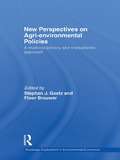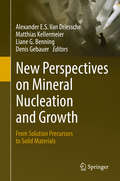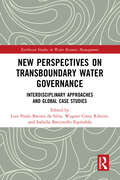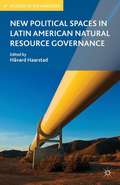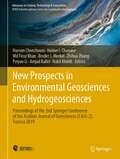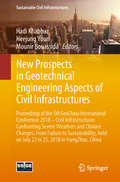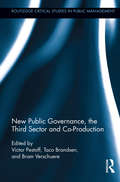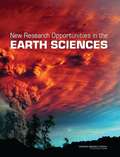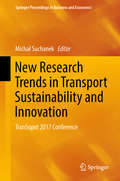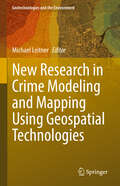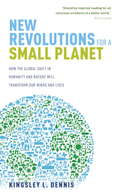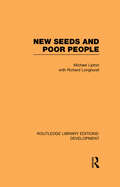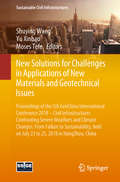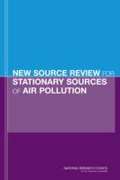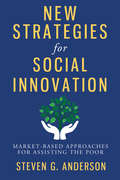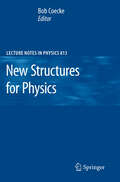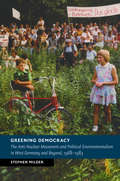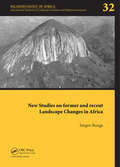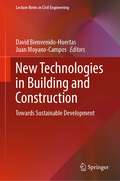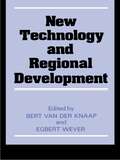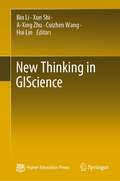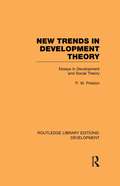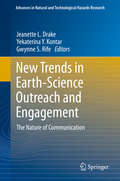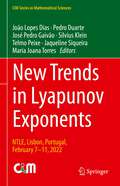- Table View
- List View
New Perspectives on Agri-environmental Policies: A Multidisciplinary and Transatlantic Approach (Routledge Explorations In Environmental Economics Ser. #22)
by Floor Brouwer Stephan J. GoetzSignificant advances have occurred in recent years in Europe and in North America in addressing agri-environmental policies. Land use issues tend to be more pressing in Europe than in the US as a whole because of different spatial exigencies. Because these advances have taken place within individual academic disciplines, there has been something of a loss of synergy and often efforts are duplicated. While important institutional and legal differences still exist between the two continents, the sharing of recent scientific advances will benefit scientists on both sides of the Atlantic and this is the main purpose of this book. The authors aim to identify options for policy to overcome the challenges ahead, synthesize existing knowledge, and identify gaps in current knowledge. This is aided by the adoption of a properly comparative approach.
New Perspectives on Mineral Nucleation and Growth
by Alexander E.S. Van Driessche Matthias Kellermeier Liane G. Benning Denis GebauerIn the last decade, numerous studies have demonstrated the existence of alternative pathways to nucleation and crystallisation that oppose the classical view. Such proposed scenarios include multistage reactions proceeding via various precursor species and/or intermediate phases. The aim of this book is to review and discuss these recent advances in our understanding of the early stages of mineralisation through a series of contributions that address both experimental and theoretical studies about the formation and nature of initial precursor species (e. g. , prenucleation clusters, dense liquid phases, amorphous nanoparticles, etc. ) as well as their transformations leading to the stable mineral phase. Several chapters are devoted to cutting-edge analytical techniques used for investigating the above processes in situ, in real time and at conditions relevant to both natural and industrial processes. At the end of the book, the editors summarize the key questions that still need to be addressed in order to establish a complete picture of the nucleation and growth processes involved during the formation of minerals
New Perspectives on Transboundary Water Governance: Interdisciplinary Approaches and Global Case Studies (Earthscan Studies in Water Resource Management)
by Wagner Costa Ribeiro da Silva, Luis Paulo Batista Isabela Battistello EspíndolaThis book presents a novel examination of transboundary water governance, drawing on global case studies and applying new theoretical approaches. Excessive consumption and degradation of natural resources can either heighten the risks of conflicts or encourage cooperation within and among countries, and this is particularly pertinent to the governance of water. This book fills a lacuna by providing an interdisciplinary examination of transboundary water governance, presenting a range of novel and emerging theoretical approaches. Acknowledging that issues vary across different regions, the book provides a global view from South and Central America, Africa, Asia, and the Middle East, with the case studies offering civil society and public managers concrete situations that indicate difficulties and successes in water sharing between bordering countries. The volume highlights the links between natural resources, political geography, international politics, and development, with chapters delving into the role of paradiplomacy, the challenges of climate change adaptation, and the interconnections between aquifers and international development. With rising demand for water in the face of climate change, this book aims to stimulate further theoretical, conceptual, and methodological debate in the field of transboundary water governance to ensure peaceful and fair access to shared water resources. This book will be of interest to students and scholars of water resource governance from a wide variety of disciplines, including geography, international relations, global development, and law. It will also be of interest to professionals and policymakers working on natural resource governance and international cooperation.
New Political Spaces in Latin American Natural Resource Governance (Studies of the Americas)
by Håvard HaarstadCase studies written by anthropologists, geographers, political scientists, and sociologists provide empirical detail and analytical insight into states' and communities' relations to natural resource sectors, and show how resource dependencies continue to shape their political spaces.
New Prospects in Environmental Geosciences and Hydrogeosciences: Proceedings of the 2nd Springer Conference of the Arabian Journal of Geosciences (CAJG-2), Tunisia 2019 (Advances in Science, Technology & Innovation)
by Zhihua Zhang Amjad Kallel Nabil Khélifi Haroun Chenchouni Helder I. Chaminé Broder J. Merkel Md Firoz Khan Peiyue LiThis edited book gives a general overview on current research, focusing on geoenvironmental issues and challenges in hydrogeosciences in model regions in Asia, Europe, and America, with a focus on the Middle East and Mediterranean region and surrounding areas. This proceedings book is based on the accepted papers for oral/poster presentations at the 2nd Springer Conference of the Arabian Journal of Geosciences (CAJG-2), Tunisia 2019. It offers a broad range of recent studies that discuss the latest advances in geoenvironmental and hydrogeosciences from diverse backgrounds including climate change, geoecology, biogeochemistry, water resources management, and environmental monitoring and assessment. It shares insights on how the understanding of ecological, climatological, oceanic and hydrological processes is the key for improving practices in environment management, including the eco-responsibility, scientific integrity, and social and ethical dimensions. It is of interest to scientists, engineers, practitioners, and policymakers in the field of environmental sciences including climatology, oceanography, ecology, biogeochemistry, environmental management, hydrology, hydrogeology, and geosciences in general. In particular, this book is of great value to students and environment-related professionals for further investigations on the state of Earth systems.
New Prospects in Geotechnical Engineering Aspects of Civil Infrastructures: Proceedings of the 5th GeoChina International Conference 2018 – Civil Infrastructures Confronting Severe Weathers and Climate Changes: From Failure to Sustainability, held on July 23 to 25, 2018 in HangZhou, China (Sustainable Civil Infrastructures)
by Mounir Bouassida Hadi Khabbaz Heejung YounThis book presents new studies by a group of researchers and practitioners to address many geotechnical challenges, based on the state-of-the-art practices, innovative technologies, new research results and case histories in construction and design towards safer infrastructures. The book provides an advancement in technologies to incorporate the impact of global climate change, world's population is rising fast and the rate of urbanization on civil infrastructures. Papers were selected from the 5th GeoChina International Conference 2018 – Civil Infrastructures Confronting Severe Weathers and Climate Changes: From Failure to Sustainability, held on July 23 to 25, 2018 in HangZhou, China.
New Public Governance, the Third Sector, and Co-Production (Routledge Critical Studies in Public Management)
by Taco Brandsen Bram Verschuere Victor PestoffIn recent years public management research in a variety of disciplines has paid increasing attention to the role of citizens and the third sector in the provision of public services. Several of these efforts have employed the concept of co-production to better understand and explain this trend. This book aims to go further by systematizing the growing body of academic papers and reports that focus on various aspects of co-production and its potential contribution to new public governance. It has an interdisciplinary focus that makes a unique contribution to the body of knowledge in this field, at the cross-roads of a number of disciplines - including business administration, policy studies, political science, public management, sociology, third sector studies, etc. The unique presentation of them together in this volume both allows for comparing and contrasting these different perspectives and for potential theoretical collaboration and development. More particularly, this volume addresses the following concerns: What is the nature of co-production and what challenges does it face? How can we conceptualize the concept of co-production? How does co-production works in practice? How does co-production unfold in reality? What can be the effects of co-production? And more specific, firstly, how can co-production contribute to service quality and service management in public services, and secondly, what is the input of co-production on growing citizen involvement and development of participative democracy?
New Research Opportunities in the Earth Sciences
by Committee on New Research Opportunities in the Earth Sciences at the National Science FoundationThe 2001 National Research Council (NRC) report Basic Research Opportunities in Earth Science (BROES) described how basic research in the Earth sciences serves five national imperatives: (1) discovery, use, and conservation of natural resources; (2) characterization and mitigation of natural hazards; (3) geotechnical support of commercial and infrastructure development; (4) stewardship of the environment; and (5) terrestrial surveillance for global security and national defense. This perspective is even more pressing today, and will persist into the future, with ever-growing emphasis. Today's world-with headlines dominated by issues involving fossil fuel and water resources, earthquake and tsunami disasters claiming hundreds of thousands of lives and causing hundreds of billions of dollars in damages, profound environmental changes associated with the evolving climate system, and nuclear weapons proliferation and testing-has many urgent societal issues that need to be informed by sound understanding of the Earth sciences. A national strategy to sustain basic research and training of expertise across the full spectrum of the Earth sciences is motivated by these national imperatives. New Research Opportunities in the Earth Sciences identifies new and emerging research opportunities in the Earth sciences over the next decade, including surface and deep Earth processes and interdisciplinary research with fields such as ocean and atmospheric sciences, biology, engineering, computer science, and social and behavioral sciences. The report also identifies key instrumentation and facilities needed to support these new and emerging research opportunities. The report describes opportunities for increased cooperation in these new and emerging areas between EAR and other government agency programs, industry, and international programs, and suggests new ways that EAR can help train the next generation of Earth scientists, support young investigators, and increase the participation of underrepresented groups in the field.
New Research Trends in Transport Sustainability and Innovation: Transopot 2017 Conference (Springer Proceedings In Business And Economics)
by Michał SuchanekThis proceedings volume examines the effects of transport on socio-economic development including innovation, public health and cultural behavior. Featuring contributions presented at the 2017 TranSopot Conference in Sopot, Poland, the enclosed papers are divided to provide emerging research in transport sustainability, innovation, structure, and in municipal transport economics. Collectively, the contributions provide not only the theoretical background for transport analysis but also empirical data and practical applications. Researchers in the transport sector strive to explore the nuances of various aspects of transport economics, which are connected on many levels. The sustainability of transport fits into a wide perspective of the sustainable economy. It treats the activities of individuals, companies and local, regional and national governments as means of achieving economic and social ends. Conversely, transport sustainability has a certain burden on society as it may generate external costs in the form of congestion, pollution and negative health effects. Many of these adverse effects might be counteracted by transport innovations, both the technical ones and the organizational ones. These innovations, while their main goal might be to increase the efficiency of the transport entities, should also fit into the desirable trend of responsible economic design thinking. These general ideas of transport research naturally have to influence the research in various branches of transport ranging from the road transport to railway. Lastly, there is the municipal transport, in which goals of different stakeholders are often contradictory which leads to highly complicated decision problems. Featuring case examples on topics as bike sharing, green travel, compact cars, freight transport and electric cars, this book will be of interest to researchers, practitioners, policy makers and students in the fields of transport economics, innovation, and sustainability.
New Research in Crime Modeling and Mapping Using Geospatial Technologies (Geotechnologies and the Environment #27)
by Michael LeitnerThis edited volume offers innovative research and applications in the analysis, modelling, and mapping of crime using geospatial and GeoAI technologies. This is a follow-up publication of an edited volume by the same editor with a similar title, Crime Modeling and Mapping Using Geospatial Technologies, published by Springer in its popular Geotechnologies and the Environment series in 2013. The book comprises sixteen chapters authored by some of the most esteemed researchers in the field. These chapters are organized into four sections: big data and microspaces (Part I), mobility (Part II), drugs (Part III), and additional geospatial applications (Part IV). Part I includes five chapters focusing on interactive crime mapping by using large data sets obtained from social media and analyzing these data using AI applications; a fundamental spatial problem that considers spatial properties of a crime dataset to determine an adequate areal unit size; different aspects of the influence or prediction of crime in microspaces; and the use of sampled surface pollen to model the search space for documented forensic cases. Part II has four chapters that introduce two route generation heuristics that automate the creation of hot spots policing patrol routes; discuss how to optimize police response with two different maximal covering location problems; and examine how human mobility patterns impact crime trends and modelling. Part III consists of three chapters addressing opioid overdose patterns using a spatial mixed methods approach; spatial-temporal changes in hot spots of drug-related offences; and how geospatial technology can be used to empower stakeholders to make informed policy decisions about alcohol-related motor vehicle collisions. Part IV comprises four diverse chapters that do not fit under a single theme. The topics discussed include: the impact of video surveillance on the spatial distribution of crime; the identification of the location of missing persons outreach events with spatial clustering analysis methods; an examination of the distribution patterns of all types of juvenile delinquency to investigate underlying factors; and a review and comparison of GeoAI methods for detecting and mapping illegal logging. This book would be useful to faculty, students and research scholars from geography, sociology, criminal justice, criminology, forensic sciences, and other related disciplines as well as to crime analysts working for law enforcement agencies at the local, state, or federal levels from around the world.
New Revolutions for a Small Planet
by Kingsley DennisHumanity is in the midst of great transformation. Our world is undergoing three types of revolution, all co-dependent: physical, psychic and cosmological. The media report dramatic changes due to climatic disruption: earthquakes, floods, hurricanes, and volcanic eruptions. We are also witnessing a surge in popular protest, as decades of corrupt or inefficient social systems face their nemesis. Yet within this outward turmoil more subtle shifts are occurring, such as the transition of the 'modern' mind from the industrial-globalisation model towards a life-sustaining, ecological-cosmological world-view. Western thinking, with its linear notion of history and progress, has robbed us of enchantment. Many ancient teachings (both spiritual and secular) and many indigenous cultures speak to us of cyclic processes over long periods of historical time. This book looks at the concept of the Hindu Yugas (great cycles) that reflect the rise and fall of civilisations, as well as ebbs and flows in our moral and intellectual health. In the years to come, humanity will adapt itself to a world in revolution, and our lives will be re-energised. This book provides a user's guide to new worlds and new world-views, and to 'a fresh release of spiritual energy'.
New Seeds and Poor People (Routledge Library Editions: Development)
by Michael Lipton Richard LonghurstFirst published in 1989, this book deals with the impact of cereal production upon the Third World, specifically ‘Modern Varieties’ (MVs). Using evidence from plant breeding, economics and nutrition science, the authors seek to pinpoint what has been achieved, what has gone wrong and what needs to be done in future. Although the technical innovations of MVs mean more employment, cheaper food and less risk for small farmers, the reduction in crop diversity increases the risk of danger from pests and though MVs enlarge cereal stocks, many are too poor to afford them. The book concludes that technical breakthroughs alone won’t solve deep-rooted social problems and that only new policies and research priorities will increase the choices, assets and power of the rural poor.
New Slow City
by William PowersBurned-out after years of doing development work around the world, William Powers spent a season in a 12-foot-by-12-foot cabin off the grid in North Carolina, as recounted in his award-winning memoir Twelve by Twelve. Could he live a similarly minimalist life in the heart of New York City? To find out, Powers and his wife jettisoned 80 percent of their stuff, left their 2,000-square-foot Queens townhouse, and moved into a 350-square-foot "micro-apartment” in Greenwich Village. Downshifting to a two-day workweek, Powers explores the viability of Slow Food and Slow Money, technology fasts and urban sanctuaries. Discovering a colorful cast of New Yorkers attempting to resist the culture of Total Work, Powers offers an inspiring exploration for anyone trying to make urban life more people- and planet-friendly.
New Solutions for Challenges in Applications of New Materials and Geotechnical Issues: Proceedings of the 5th GeoChina International Conference 2018 – Civil Infrastructures Confronting Severe Weathers and Climate Changes: From Failure to Sustainability, held on July 23 to 25, 2018 in HangZhou, China (Sustainable Civil Infrastructures)
by Shuying Wang Yu Xinbao Moses TefeThis book include research studies which deal with the attempts to address new solutions for challenges in geotechnical engineering such as characterization of new materials, application of glass fibre, geotextile fabric and permeable concrete, new numerical methods for traditional problems and some other geotechnical issues that are becoming quite relevant in today's world. The book adds to the geotechnical engineering field which still bears lots of big challenges. It contributes to make the civil infrastructures more sustainable using new technologies and materials that have been proposed and applied in various fields. Papers were selected from the 5th GeoChina International Conference 2018 – Civil Infrastructures Confronting Severe Weathers and Climate Changes: From Failure to Sustainability, held on July 23 to 25, 2018 in HangZhou, China.
New Source Review For Stationary Sources Of Air Pollution
by National Research Council of the National AcademiesThe Clean Air Act established a pair of programs—known as New Source Review (NSR)—that regulate large stationary sources of air pollution, such as factories and electricity-generating facilities. Congress then asked the National Research Council to estimate the effects of NSR rule changes made in 2002 and 2003 in terms of the effects on emissions and human health, and changes in operating efficiency (including energy efficiency), pollution prevention, and pollution-control activities. New Source Review for Stationary Sources of Air Pollution provides insights into the potential effects of the rule changes on national emissions from the electric power industry. Although this book focuses on the 2002 and 2003 rules, its analytic framework applies to other possible changes in NSR and to other regulatory contexts. Helpful, in that it outlines the data-collection efforts needed to assess the impact of the NSR rules, the book recommends EPA and other government agencies undertake and sustain the recommended methods.
New Strategies for Social Innovation: Market-Based Approaches for Assisting the Poor
by Anderson Steven G.This book is the first to assess emerging market-based social change approaches comparatively, focusing specifically on social entrepreneurship, corporate social responsibility, fair trade, and private sustainable development
New Structures for Physics
by Bob CoeckeThis volume provides a series of tutorials on mathematical structures which recently have gained prominence in physics, ranging from quantum foundations, via quantum information, to quantum gravity. These include the theory of monoidal categories and corresponding graphical calculi, Girard's linear logic, Scott domains, lambda calculus and corresponding logics for typing, topos theory, and more general process structures. Most of these structures are very prominent in computer science; the chapters here are tailored towards an audience of physicists.
New Studies in European History: The Anti-Nuclear Movement and Political Environmentalism in West Germany and Beyond, 1968–1983 (New Studies in European History)
by Stephen MilderGreening Democracy explains how nuclear energy became a seminal political issue and motivated new democratic engagement in West Germany during the 1970s. Using interviews, as well as the archives of environmental organizations and the Green party, the book traces the development of anti-nuclear protest from the grassroots to parliaments. It argues that worries about specific nuclear reactors became the basis for a widespread anti-nuclear movement only after government officials' unrelenting support for nuclear energy caused reactor opponents to become concerned about the state of their democracy. Surprisingly, many citizens thought transnationally, looking abroad for protest strategies, cooperating with activists in other countries, and conceiving of 'Europe' as a potential means of circumventing recalcitrant officials. At this nexus between local action and global thinking, anti-nuclear protest became the basis for citizens' increasing engagement in self-governance, expanding their conception of democracy well beyond electoral politics and helping to make quotidian personal concerns political.
New Studies on Former and Recent Landscape Changes in Africa: Palaeoecology of Africa 32 (Palaeoecology of Africa)
by Jürgen RungeVolume 32 (2013) of the internationally recognized and acclaimed yearbook seriesPalaeoecology of Africa publishes 9 new interdisciplinary scientific papers on former and recent landscape evolution and on past environments of the African continent (e.g. climate change, vegetation dynamics and growing impact of humans on ecosystems). These papers
New Technologies in Building and Construction: Towards Sustainable Development (Lecture Notes in Civil Engineering #258)
by David Bienvenido-Huertas Juan Moyano-CamposThis book presents contributions on new technologies in building and construction. Buildings are complex elements that impact environment significantly. The sustainability of this sector requires a holistic and multidisciplinary approach that allows adequate strategies to be established to reduce its environmental impact. This heterogeneity is represented in these chapters, which have been developed by researchers from different countries. The book is divided into three sections: (i) analysis, (ii) design and modeling, and (iii) solutions. The book chapters together represent an advance in current knowledge about new technologies in building and construction, crucial for researchers, engineers, architects, policy makers, and stakeholders.
New Technology and Regional Development
by Egbert Wever Bert Van Der KnappFirst Published in 2004. Routledge is an imprint of Taylor & Francis, an informa company.
New Thinking in GIScience
by Bin Li Hui Lin Xun Shi A-Xing Zhu Cuizhen WangThis book is a collection of seminal position essays by leading researchers on new development in Geographic Information Sciences (GIScience), covering a wide range of topics and representing a variety of perspectives. The authors propose enrichments and extensions to the conceptual framework of GIScience; discuss a series of transformational methodologies and technologies for analysis and modeling; elaborate on key issues in innovative approaches to data acquisition and integration, across earth sensing to social sensing; and outline frontiers in application domains, spanning from natural science to humanities and social science, e.g., urban science, land use and planning, social governance, transportation, crime, and public health, just name a few. The book provides an overview of the strategic directions on GIScience research and development. It will benefit researchers and practitioners in the field who are seeking a high-level reference regarding those directions.
New Trends in Development Theory: Essays in Development and Social Theory (Routledge Library Editions: Development)
by Peter PrestonThe theme of this work, first published in 1985, is the exchange between issues of development and problems of social theory. They provide preliminary analysis of the multiplicity of social-theoretic arguments in development theory and their implications for social theory in general. The book will be of interest to all those interested in the contemporary ‘restructuring’ of social theory and to theorists of development who are rethinking their concerns in a period of pessimism and doubt.
New Trends in Earth-Science Outreach and Engagement
by Jeanette L. Drake Yekaterina Y. Kontar Gwynne S. RifePerhaps just as perplexing as the biggest issues at the core of Earth science is the nature of communicating about nature itself. New Trends in Earth-Science Outreach and Engagement: The Nature of Communication examines the processes of communication necessary in bridging the chasm between climate change and natural hazard knowledge and public opinion and policy. At this junction of science and society, 17 chapters take a proactive and prescriptive approach to communicating with the public, the media, and policy makers about the importance of Earth science in everyday life. Book chapters come from some 40 authors who are geophysical scientists, social scientists, educators, scholars, and professionals in the field. Bringing diverse perspectives, these authors hail from universities, and research institutes, government agencies, non-profit associations, and corporations. They represent multiple disciplines, including geosciences, education, climate science education, environmental communication, and public policy. They come from across the United States and around the world. Arranged into five sections, the book looks at geosciences communication in terms of: 1) Education 2) Risk management 3) Public discourse 4) Engaging the public 5) New media From case studies and best practices to field work and innovations, experts deliver pragmatic solutions and delve into significant theories, including diffusion, argumentation, and constructivism, to name a few. Intended for environmental professionals, researchers, and educators in the geophysical and social sciences, the book emphasizes communication principles and practices within an up-to-the-minute context of new environmental issues, new technologies, and a new focus on resiliency.
New Trends in Lyapunov Exponents: NTLE, Lisbon, Portugal, February 7–11, 2022 (CIM Series in Mathematical Sciences)
by Pedro Duarte Silvius Klein João Lopes Dias José Pedro Gaivão Telmo Peixe Jaqueline Siqueira Maria Joana TorresThis volume presents peer-reviewed surveys on new developments in the study of Lyapunov exponents in dynamical systems and its applications to other areas, such as mathematical physics. Written by leading experts in their fields, the contributions are based upon the presentations given by invited speakers at the “New Trends in Lyapunov Exponents” workshop held in Lisbon, Portugal, February 7–11, 2022. The works focus on the concept of Lyapunov exponents in their various manifestations in dynamical systems along with their applications to mathematical physics and other areas of mathematics. The papers reflect the spirit of the conference of promoting new connections among different subjects in dynamical systems. This volume aims primarily at researchers and graduate students working in dynamical systems and related fields, serving as an introduction to active fields of research and as a review of recent results as well.
